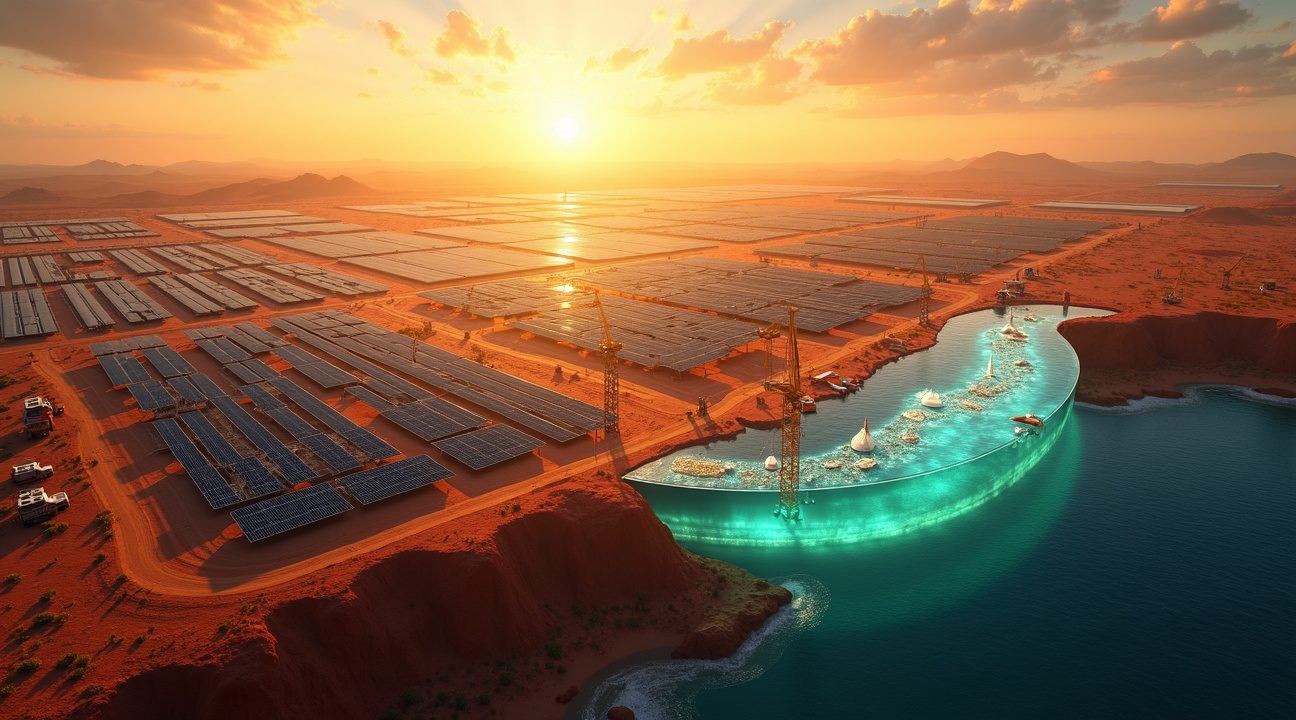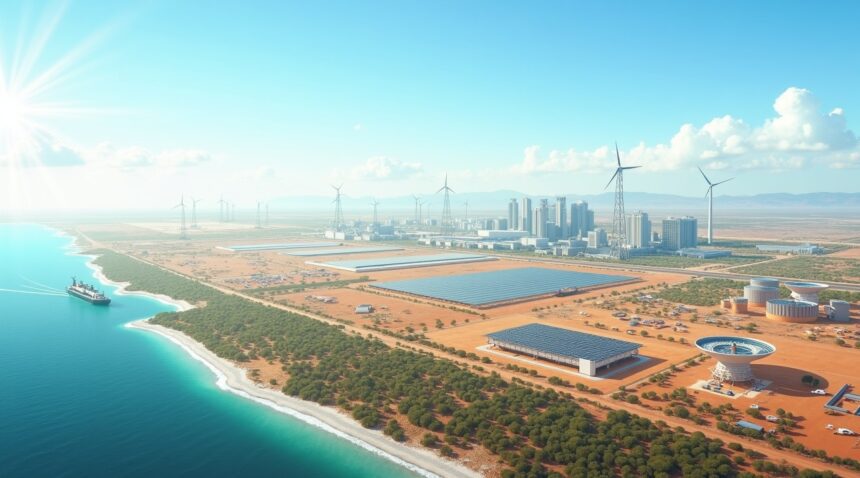Australia’s groundbreaking Australia-Asia PowerLink project aims to revolutionize international clean energy transmission by creating the world’s longest undersea power cable, delivering solar energy from Australia to Singapore.
Key Takeaways
- The project spans an unprecedented 4,300 kilometers underwater, making it five times longer than any existing undersea power cable. It will utilize advanced HVDC (High Voltage Direct Current) transmission technology to ensure power quality remains intact over such a vast distance.
- Singapore will source 15% of its electricity from Australian solar power, significantly reducing its carbon footprint by 8.6 million tonnes per year and lessening dependence on imported natural gas.
- Economic benefits for Australia’s Northern Territory exceed $20 billion, with 1,750 direct construction jobs, 350 permanent operational roles, and 12,000 indirect jobs across Australia, Singapore, and Indonesia expected to be created.
- The solar installation will span 12,000 hectares in Powell Creek, Northern Territory, and include 36-42 gigawatt-hours of battery storage to ensure consistent energy delivery even during adverse weather or nighttime hours.
- Construction began in 2023, with initial power delivery anticipated in 2027. This project positions Australia as a major renewable energy exporter and forms a model for future international clean energy collaborations in the Asia-Pacific region.
For readers interested in the details and long-term vision of this transformative energy project, visit the official Sun Cable website.
World’s Largest Solar Project Will Power 4.2 Million Homes Across Two Countries
I can see how the Australia-Asia PowerLink represents a monumental leap in renewable energy infrastructure, setting new benchmarks for international power sharing. This groundbreaking initiative will establish a renewable energy precinct of unprecedented scale, featuring 17–20 gigawatts of solar capacity paired with 36–42 gigawatt-hours of storage capability.
The project centers around a massive 12,000-hectare solar farm located at Powell Creek in Australia’s Northern Territory. This sprawling installation dwarfs most existing solar facilities and incorporates cutting-edge utility-scale battery storage systems that ensure consistent power delivery even when the sun isn’t shining. The strategic positioning in Northern Territory takes advantage of some of the world’s most reliable solar irradiation levels, maximizing energy generation throughout the year.
Massive Scale and Economic Investment
The numbers behind this project showcase its extraordinary ambition. Once operational, the facility will generate sufficient clean energy to power approximately 4.2 million homes across both Australia and Singapore. This energy output positions the project as a game-changer for regional power security and carbon reduction goals.
Financial projections for the Australia-Asia PowerLink range between $13.5–30 billion, with costs varying based on expansion scope and construction phases. SunCable, the company spearheading this initiative, has structured the development to accommodate phased implementation, allowing for gradual scaling while maintaining financial viability. The investment represents one of the largest renewable energy commitments globally, reflecting the serious intent behind this ambitious undertaking.
The project relies heavily on advanced HVDC transmission technology to efficiently transport power across vast distances with minimal energy loss. This high-voltage direct current system proves essential for the 4,300-kilometer undersea cable that will connect Australia’s solar resources to Singapore’s energy grid. The technological complexity matches the project’s scale, requiring innovations in both solar generation and long-distance power transmission.
Singapore’s participation as a major stakeholder highlights the growing trend of international renewable energy partnerships. The city-state’s limited land area restricts domestic renewable energy development, making this arrangement particularly valuable for meeting climate commitments. Australia benefits by monetizing its abundant solar resources while contributing to regional decarbonization efforts.
The storage component addresses one of solar power’s primary challenges – intermittency. With battery capacity measured in gigawatt-hours rather than megawatt-hours, this project can store enough energy to maintain consistent supply during extended cloudy periods or nighttime hours. This reliability factor makes the project viable for baseload power supply, traditionally dominated by fossil fuel plants.
Construction timelines span multiple phases, with initial operations expected to begin serving domestic Australian demand before the undersea cable becomes operational. This approach allows for system testing and optimization while generating revenue to support ongoing development costs.
For more on SunCable and the Australia-Asia PowerLink, you can visit the official SunCable website.
https://www.youtube.com/watch?v=2xbZOMhL98A
Record-Breaking 4,300 Kilometer Undersea Cable Will Dwarf All Previous Projects
I can’t help but marvel at the sheer audacity of this engineering feat. The proposed undersea cable stretching 4,300 kilometers from Australia to Singapore will shatter every existing record for undersea power transmission. This high-voltage direct current cable dwarfs previous projects by an astounding margin—it’s five times longer than any undersea power cable ever constructed.
Unprecedented Scale Challenges Engineering Limits
The cable’s immense length becomes clear when compared to familiar geographic references. It spans a distance comparable to nearly the entire east-west reach of the continental United States. Previous undersea power cables pale in comparison to this ambitious project. Most existing installations measure hundreds of kilometers rather than thousands, making this Australian-Singapore connection a genuine leap into uncharted territory.
HVDC technology enables this extraordinary distance because it maintains power quality better than traditional alternating current systems over long transmission routes. The direct current system reduces electrical losses that would otherwise make such a project economically unfeasible. Even with advanced HVDC technology, engineers face unprecedented challenges in maintaining signal integrity across such vast underwater distances.
Advanced Materials Defend Against Deep-Sea Hazards
The cable’s construction reflects the harsh realities of deep-ocean environments. Engineers have designed a multi-layered protection system that combines several critical components:
- Copper conductors form the cable’s core, providing efficient electrical transmission
- Lead alloy sheathing creates a moisture barrier essential for long-term reliability
- Polyethylene layers add flexibility and additional protection against water intrusion
- Steel armor provides the outermost defense against marine hazards and physical damage
Each layer serves a specific purpose in defending against the corrosive effects of saltwater, extreme pressures at ocean depths, and potential damage from fishing equipment or ship anchors. The steel armor particularly addresses concerns about cable breaks that could disrupt power flow and require costly repairs in remote ocean locations.
Deep-sea installation requires specialized vessels and techniques that few companies worldwide possess. Cable-laying ships must navigate complex ocean currents while maintaining precise positioning to ensure proper cable placement on the seafloor. Weather windows for installation work are limited, adding another layer of complexity to the project timeline.
An 800-kilometer overhead HVDC line will transport power from the solar installation to Darwin, where the undersea journey begins. This terrestrial connection faces its own engineering challenges as it crosses Australia’s varied terrain. Darwin will host a utility-scale battery facility positioned strategically near the coast to provide power conditioning and storage capabilities.
The solar farm’s photovoltaic modules represent another innovation in the project. Australian firm 5B has designed prefabricated solar arrays that will be manufactured in Darwin. This approach reduces transportation costs and allows for quality control closer to the installation site. Prefabrication also accelerates deployment timelines compared to traditional field assembly methods.
Singapore’s energy security drives much of the project’s economic justification. The city-state currently imports most of its energy needs and sees Australian solar power as a pathway to reduce dependence on fossil fuel imports. The project promises to deliver clean energy at competitive rates while diversifying Singapore’s energy portfolio.
Australia’s abundant solar resources make this transcontinental power export economically viable despite the enormous infrastructure investment required. Large-scale infrastructure projects often push technological boundaries, and this cable project continues that tradition. The Northern Territory’s solar potential remains largely untapped, and this project could unlock massive renewable energy exports.
Installation timelines stretch across several years due to the project’s complexity and scale. Cable manufacturing alone requires substantial lead times given the unprecedented length requirements. Environmental assessments must account for marine ecosystems across multiple national jurisdictions between Australia and Singapore.
Singapore Will Receive 15% of Its Electricity Needs While Cutting 8.6 Million Tonnes of CO2 Annually
The AAPowerLink project represents a transformative shift in how nations approach energy security and climate goals. This groundbreaking infrastructure will deliver between 1.75 and 2 GW of clean electricity directly to Singapore, meeting approximately 15% of the nation’s total electricity demand through renewable energy sources.
Singapore’s current energy landscape heavily depends on natural gas, which accounts for 94% of its power generation. The massive undersea cable will fundamentally change this dependency by providing a reliable alternative that reduces the nation’s carbon footprint by an estimated 8.6 million tonnes of carbon dioxide emissions annually. This reduction equals removing roughly 1.8 million cars from Singapore’s roads each year.
Meeting Regional Energy Demands
The timing of this project couldn’t be more critical. Regional projections indicate that electricity demand across the Asia-Pacific will surge by 70% by 2040 and more than double by 2050. Singapore’s strategic investment in Australian renewable energy positions the island nation ahead of this curve while securing long-term energy stability.
Australia’s vast renewable resources make it an ideal partner for Singapore’s decarbonization efforts. The continent receives some of the world’s highest solar irradiation levels, particularly in its northern regions where the AAPowerLink solar farm will be located. This natural advantage allows Australia to generate clean electricity at scale and export it efficiently through underwater transmission technology.
The project also demonstrates how international cooperation can accelerate regional climate action. Rather than each nation building isolated renewable capacity, the cable creates a shared energy ecosystem that maximizes efficiency and reduces overall infrastructure costs. Singapore benefits from accessing Australia’s superior renewable resources without requiring vast land areas for solar installations.
From an economic perspective, the 15% electricity contribution from AAPowerLink provides Singapore with energy price stability and reduced exposure to volatile fossil fuel markets. Natural gas prices have experienced significant fluctuations in recent years, making renewable energy imports an attractive hedge against future price volatility.
Australia’s role as a regional clean energy supplier extends beyond this single project. The success of AAPowerLink could establish a template for similar initiatives connecting Australia’s renewable abundance with energy-hungry neighbors throughout Southeast Asia. Solar power technology continues advancing, making these long-distance transmission projects increasingly viable.
The environmental impact extends beyond carbon reduction. By displacing natural gas consumption, the project reduces Singapore’s reliance on liquefied natural gas imports, which involve energy-intensive transportation and processing. Each gigawatt-hour of renewable electricity transmitted through the cable prevents multiple forms of environmental impact associated with fossil fuel extraction, processing, and combustion.
Singapore’s commitment to receiving 15% of its electricity from this renewable source signals a broader shift in energy policy. The nation has set ambitious targets for carbon neutrality, and projects like AAPowerLink provide practical pathways to achieve these goals without compromising economic growth or energy security.
The cable’s capacity to deliver up to 2 GW represents substantial baseload power that can operate continuously, unlike intermittent renewable sources that depend on weather conditions. Australia’s solar resources, combined with potential battery storage systems, ensure consistent power delivery across the 4,200-kilometer transmission distance.
This initiative positions both nations as leaders in renewable energy innovation and international cooperation. Singapore gains access to clean, affordable electricity while Australia monetizes its renewable energy potential through exports. The 8.6 million tonnes of annual CO2 reduction contributes meaningfully to global climate targets while demonstrating the commercial viability of large-scale renewable energy trading between nations.

Economic Boom Expected to Generate $20 Billion and Thousands of Jobs Across Three Countries
This ambitious undersea cable project represents far more than a technological achievement – it’s positioned to deliver massive economic benefits that will reshape Australia’s energy sector for decades. The AAPowerLink initiative promises to generate over $20 billion in economic value specifically for Australia’s Northern Territory during its 35-year construction phase, establishing the region as a powerhouse in renewable energy infrastructure.
Job Creation Spanning Multiple Decades
The employment opportunities this project creates are staggering in both scale and duration. Construction alone will generate 1,750 direct jobs, while ongoing operations will sustain 350 permanent positions throughout the facility’s operational period. These figures represent just the tip of the employment iceberg, as the project is expected to create an additional 12,000 indirect jobs across Australia, Singapore, and Indonesia over its projected 70-year operational lifespan.
I find it particularly noteworthy that these employment benefits extend well beyond Australia’s borders, strengthening economic ties with key regional partners. Construction workers, engineers, technicians, and support staff will find opportunities throughout the project’s various phases, from initial solar farm development to ongoing maintenance of the world’s longest undersea power cable.
Strategic Positioning and Community Benefits
AAPowerLink strategically positions Australia as a global leader in renewable energy infrastructure, featuring what will become the largest combined solar and battery system worldwide. This positioning creates long-term competitive advantages that extend far beyond the immediate economic impact figures. The project enhances critical partnerships between Australia, Indonesia, and Singapore, fostering regional cooperation in clean energy development.
First Nations communities receive particular emphasis in the project’s planning, with dedicated opportunities designed to ensure Indigenous Australians benefit directly from this transformative infrastructure development. These initiatives recognize the importance of inclusive economic growth while respecting traditional land connections.
The economic ripple effects will likely extend into related industries, from manufacturing and logistics to specialized engineering services. Local suppliers, transportation companies, and service providers across the three-country corridor stand to benefit from sustained demand over multiple decades. Solar energy projects of this magnitude typically create economic momentum that persists long after initial construction phases complete, establishing Northern Australia as a renewable energy export hub with global significance.

Construction Begins in 2023 With First Power Delivery Expected by 2027
The Australian government has officially granted major project status to AAPowerLink, marking a pivotal moment for the ambitious undertaking. Environmental approval for the initial phase has been secured, clearing critical regulatory hurdles that often delay large-scale infrastructure projects. This recognition signals the project’s strategic importance to Australia’s energy future and economic partnership with Singapore.
Construction activities commenced in 2023, setting in motion a complex engineering endeavor that spans multiple phases. The timeline for completion reflects the immense scope of work required, from solar farm development to underwater cable installation across thousands of kilometers. First power transmissions to Singapore are expected by 2027, establishing a new era of international renewable energy trading.
Regulatory Framework and Project Scale
The project’s unprecedented scale has helped establish clear regulatory pathways for future renewable energy initiatives. Government officials have streamlined approval processes specifically for AAPowerLink, creating precedents that could benefit similar projects across the region. This regulatory clarity addresses many uncertainties that typically surround international energy infrastructure developments.
AAPowerLink currently holds the distinction of being the largest renewable energy and transmission project under development globally. The scale encompasses not just the physical infrastructure but also the technological innovation required to maintain power quality across such vast distances. Engineers must address challenges related to:
- Power loss during long-distance transmission
- Grid stability across multiple nations
- Weather-related disruptions throughout the transmission route
The strategic significance extends beyond energy generation, positioning Australia as a major renewable energy exporter in the Asia-Pacific region. Singapore’s commitment to purchasing this solar power demonstrates growing demand for clean energy imports among developed nations with limited renewable resources. This partnership could serve as a model for other countries looking to balance their energy portfolios through international cooperation.
Project developers have coordinated with multiple government agencies to ensure smooth implementation across various jurisdictions. The approval process required extensive environmental impact assessments, particularly for marine ecosystems along the cable route. These studies have informed construction methodologies designed to minimize ecological disruption while maintaining project viability.
The 2027 target date represents more than just an operational milestone – it establishes Australia’s position in the global renewable energy market. Early power delivery will validate the technical feasibility of long-distance underwater transmission, potentially opening doors for similar projects connecting other resource-rich regions with energy-hungry markets. The success of this initial phase could accelerate plans for expanded capacity and additional international connections.
Sources:
Fortune – “Australia Approves Project Connecting Singapore to Solar Power from Australia”
Energy Storage News – “Sun Cable: Australia to Singapore renewable energy project wins transmission link approval”
PV Magazine Australia – “Federal Government keeps faith in SunCable project”
World Steel Association – “Australia-Asia PowerLink will feature world’s longest underwater cable”
Wikipedia – “Australia-Asia Power Link”
SunCable


